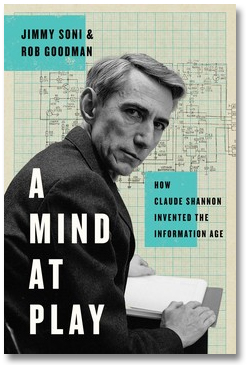A Mind at Play, book review: The life and work of information theory's founding father


A Mind at Play: How Claude Shannon Invented the Information Age • By Jimmy Soni and Rob Goodman • Simon & Schuster • ISBN: 978-1-4767-6668-3 • 366 pages • $27
Imagine a drunk stumbling down the street. We can't predict exactly when or in what direction they will stumble, but it doesn't take long for us to be able to predict with a high degree of accuracy where they're trying to go. We can also predict with some confidence that if there are lamp posts along the route, the drunk will likely navigate toward them.
This is one of the analogies Jimmy Soni and Rob Goodman use to explain information theory in A Mind at Play, the excellent new biography of information age founder Claude Shannon. Like all the best science writing, their explanation of Shannon's groundbreaking work is a deceptively simple read. What they are explaining is the basis of the communications we each engage in every day: how to transmit information efficiently and accurately even when noise makes it difficult.
Like the drunk, our use of language may seem unpredictable, but each letter we add restricts further what we will say next. This reality underlies everything we do with information -- transmit it across the world via telecommunications, encrypt it, compress it, store it, and predict it, as your smartphone does every time you start to type a text or email. Viewed as a question of the structure of information, the authors write, our "freedom of speech" is an illusion: most of our options have already been eliminated.
A lively and curious mind
From a very young age, as the authors explain, Shannon displayed a lively and curious mind. Trained as both an electrical engineer and a mathematician, he spent his career at Bell Labs and MIT, both places where he was free to explore whatever interested him. About the first half of the book covers his life until his early thirties, when his most important work was done. As Soni and Goodman note, mathematics, like sports, is a young person's game. Besides his mathematical theory of communication, during that time, he also laid the groundwork for modern signal processing and important aspects of cryptography (such as the one-time pad). Today's uses of his work would not have surprised him: in 1984 he suggested that by 2001 a computer would become world chess champion (it happened in 1997).
Shannon's later experiments with solving puzzles -- building electronic objects, mulling how to build a chess-playing machine, studying juggling, devising a Roman numeral calculator -- pointed the way ahead. One such was a system that taught an electronic mouse (which he called "Theseus") how to navigate a maze. The mouse behaves much like a Roomba does today, hitting a wall and changing direction to try again, but the machine learning system behind it is smarter, as it remembers the correct path, discarding the mistakes. One of the pleasures of modern biography-reading is that when the authors mention Shannon's filmed 1950 demonstration of Theseus at Bell Labs, one can pause to find it on YouTube. Sadly, by the early 1990s, when Shannon's work was taking over the world, Alzheimer's Disease prevented him from appreciating it.
Of course you can use the internet without understanding any of Shannon's work. But, as the authors explain, there is value in knowing how the technologies we use every day got here. This excellent biography is a good place to start.
Read more book and film reviews
- Crash Override, book review: Gamergate and the battle against online hate
Game developer Zoë Quinn recounts her experience of 'Gamergate', which prompted the creation of the Crash Override Network to provide support and advice for victims of online hate. - The Political Spectrum, book review: How wireless deregulation gave us the iPhone
Thomas Winslow Hazlett offers an accessible history of wireless technology, describing how regulators often stifled innovative competition under pressure from incumbent interests, and how deregulation eventually gave us FM radio, HBO, wi-fi, and the iPhone. - Risk, film review: Access all Assange areas, to incoherent effect
Over six years of filming, Laura Poitras follows the elusive and distant Wikileaks founder from a friend's Norfolk estate to his Ecuadorian Embassy bolt-hole. - Move Fast and Break Things, book review: Where did the internet go wrong?
Jonathan Taplin's book examines how a handful of Silicon Valley libertarians came to dominate the internet via giant companies like Google, Facebook and Amazon.